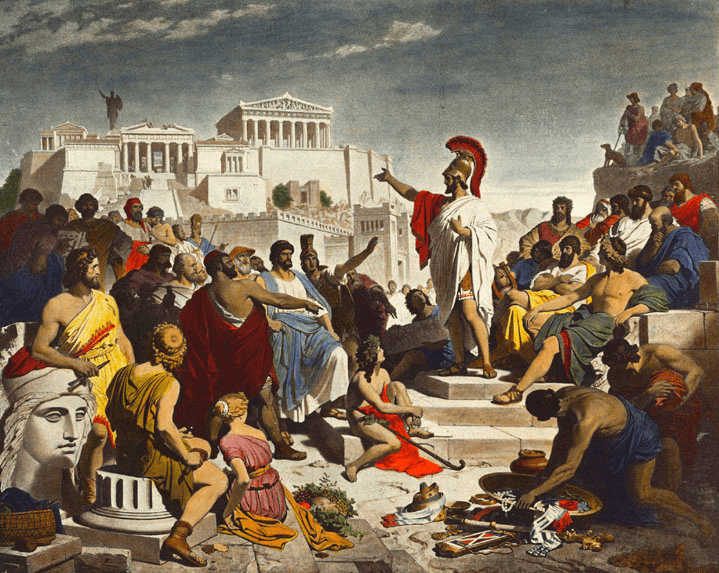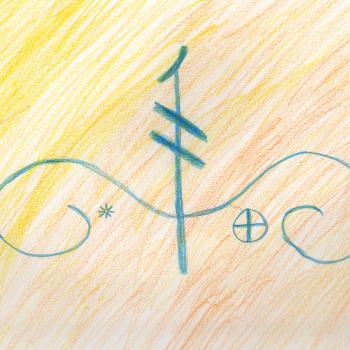Over this turn of the “Wheel of the Year”, it’s my plan to investigate and pay respect to eight archetypes of mature, sacred masculinity. The Preacher at Beltane is the fourth installment in this series.
Context
Men’s mysteries matter. Today, young men are confronted on one hand with reactionary voices who advocate gender roles decades or centuries out of date, and on the other with professional-managerial class “progressive” voice who seem to think the answer to the reactionaries is to eliminate masculinity.
The transition to manhood is dangerous. Men are both more likely than women to be murdered and to commit murder. We’re more likely to be in prison, to be killed on the job, or to commit suicide. We’re less likely to finish high school or earn college degrees.
Boys who fail to make a successful transition to manhood end up at best being a drag on society, and at worst an active threat to people’s lives. And we will not help them make the transition by denying that manhood even exists.
To help young men through the transition, a system of archetypes can be a useful guide. No such system will be complete, of course. What I’m going to talk about in this series of posts is inspired by the book King, Warrior, Magician, Lover by Robert Moore and Douglas Gillette, and also by Robert Bly’s work, but it’s my own thing. Anything smart is probably copied from those others and anything dumb here is probably my own fault.
By considering these archetypes I am not claiming that these roles are unavailable to women or nonbinary folks. Nor am I claiming that this is the only way to be a man. I’m offering some ideas that have helped me come to terms with my own existence as an adult male human being. (And cognizant that that is as a “white” heterosexual American male, though still believing there’s enough universality in the way androgens shape our brains for the exercise to be useful). If they don’t work for you, fine, please tell us your secrets! If you’re not a man and find that they work for you, great!
For each of these archetypes, we’re going to discuss a balanced version, an excess version, and a shadow version.
Visualize us going around a mountain: at the top is the Wild Man and the realm of excess, up where the air is thin. It’s exhilarating but we can’t stay there. At the bottom is the shadow realm of fear. The healthy mature man moves around the middle heights of the mountain, in neither shadow not excess, moving between the archetypes as needed. Over this series, we will visit eight points around the mountain: the Magician, the Healer, the Lover, the Preacher, the King, the Captain, the Warrior, and the Trickster.
The Preacher
Some men lead others in the context of battle or other conflict; some men lead others in political contexts, questions of how to organize and structure communities.
But some men lead others through the process of figuring out how we should live.
The name for the field of philosophy that address the question of how we should live is “ethics”, though often that word has come to mean either moralistic scolding about breaking social norms, or abstract philosophical puzzlers like the trolley problem.
But I mean here the everyday practical problem of how to live a “good” life, where “good” is not determined by “what is the size of my bank account” or “what will the neighbors think?”, or even “what will some supernatural judge think?”, but is measured by one’s own long term deep contentment.
The men we’re talking about here lead us towards the good life in that sense.
Occasionally these men are writers — especially poets — but most often they are known for their oratory, their ability to speak to groups. Sometimes they occupy a role as religious ritualists or as academic educators, but here were are focusing on their ability to inspire people.
We might name this archetype the “Preacher/Teacher”, or even the “Preacher/Teacher/Coach” to include a way in which many men encounter this archectype. (My father filled this role for many boys over the years as a baseball coach.)
But for convenience we’ll just say “Preacher”.
We can see the archetype of the Preacher in John the Baptist, crying in the wilderness “Prepare ye the way of the Lord.” Jesus and Buddha viewed through a historical lens are Preachers, though through the lenses of the faiths of their followers they are more the King archetype.
Martin Luther King was certainly a great American Preacher, as was Henry David Thoreau. (Today we tend to think of Thoreau as a writer rather then an orator, but he delivered over seventy public lectures, and many of his texts we read today were lectures first.)
Robin William’s character Mr. Keating in Dead Poet’s Society is a great fictional example.
From history, Pericles of the “golden age” of Athens, know for his funeral oration at the end of the first year of the Peloponnesian War, is one of the great examples: a man whose words helped Athenians come to a greater conception of themselves.
Think of the times your own favorite teacher went off on tangents from algebra or literature to broader issues of how to live. Or your favorite coach giving life lessons to the team rather than talking about how to throw or kick a ball. He is speaking with the intent to inspire his listeners to better lives — he is, to sum it up in a single word, preaching.
The Preacher does not issue orders or set himself above those he speaks to in a power hierarchy. The authority he has is “moral authority”, rooted in the rightness of what he says and in congruence between those words and his actions.
Authority
“Authority” is a tricky word. As a libertarian (of the small-l variety, as in “civil libertarian”), in raising the topic I don’t want to suggest that being a healthy and mature man means seeking power or dominance over others. Indeed, the opposite is true: it is the fear-filled “shadows” of the archetypes that are involved in that.
But as a man succeeds, others will look up to him. Part of the role of a man is to lead the younger or less experienced males, both in the practical tasks that have to get done for society to prosper and in their own inner journeys to mature masculinity.
Three of our archetypes — the Preacher, the King, and the Captain — deal with authority, and in the real world effective authority requires a blend of the Preacher’s moral authority, the King’s transcendent authority, and the Captain’s results-based authority.
Thus even a military leader, who we would mostly associate with the Captain, has to be able to access the Preacher’s moral authority. Gene Kamena of the Air War College gives an excellent explanation of how this authority works. While he’s speaking in a military context what he says here has universal application:
A key component of personal authority is moral authority… Moral authority emanates from within and is reflective of a leader’s character. Thus, a leader of good character generates the moral authority required to hold others to a high standard of moral and ethical behavior. Moral authority is also the basis for trust; without it, trust is never established between a leader and followers. Ultimately, moral authority translates into credibility and legitimacy. It is imperative for leaders to remember three points concerning moral authority: it is generated from within (that is, it cannot be given or granted), it is always tested and it is fragile.
There’s a story about moral authority often told about Gandhi. The same story is also told about Mullah Nasrudin, so it’s apocryphal, but we’ll stick with Gandhi for our telling.
The story goes that the mother of a young boy came to see the great man:
“Mahatma, please help me with my son. He has a terrible habit of eating sugar. I know it’s so bad for his health to eat it like he does, and it’s expensive when he filches it from the kitchen! He admires you so much, if you told him to stop, I know that he would.”
Gandhi pondered for a minute. “I can’t today, but bring the boy to me in two weeks.”
Two weeks later the mother returned, with her son. “Stop eating sugar,” Gandhi told the boy.
“Yes sir, I’ll stop,” said the son.
“Thank you sir,” the mother said, “but why couldn’t you just tell him that two weeks ago?”
“Because,” Gandhi replied, “two weeks ago I was eating sugar.”
The authority of the preacher comes from him “walking his talk”, not from any power structure. The Preacher uses that moral authority to lead a community towards a positive vision of what is possible for them.
Shadow: The Demagogue
The Preacher uses his words — especially spoken words — and a moral authority based on sincere action to lead a community to greater knowledge of itself.
The Demagogue similarly uses the power the word to lead people, but leads them into enriching and empowering him. He pretends to sincerity but his words seldom match his actions. Another word we might use for this shadow archetype is “hypocrite”.
In our modern culture they’re easy to find: switch on any televangelist, and you’ll find the shadow of the Preacher. And it’s even easier in the US this year, since it’s an election season: hypocrisy is the rule in our politics.
Excess: The Self-Elected Messiah
From Jim Jones to David Koresh, we have plenty of examples of cult leaders who had a sincere belief in what they said, who walked their talk and thought they were leading others to a better way…only to go completely and fatally off the rails. The Preacher must always keep a little self-doubt, some consciousness of his limits.
The Preacher at Beltane
I don’t know what the seasonal calendar is like where you are, but here in the mid-Atlantic, it’s in late April and early May that it’s finally warm enough to hold large, extended outdoor gatherings. The season has just started for street festivals and for camping festivals.
In the ancient Celtic world, this is when people gathered en masse for Beltane celebrations. These had ritual, political, and social structure specific to that culture, but underlying it was the seasonal cycle and the basic fact that it’s warm outside again! We no long feel the need to huddle indoors. We’re entering the half of the year marked more by gathering together.
In today’s world of mass broadcast media, a speaker can address a large audience at any time. But in earlier ages, speaking to a large audience required the right season for such an audience to gather; and even today, as we gather in person at outdoor events this time of year, the archetype of the Preacher becomes more apparent.
So take some time this season to consider your relationship with this archetype.
Evocation of the Preacher/Teacher
I evoke and call forth
The Teacher, the Preacher
I honor and acknowledge
My capacity to inspire others
I resolve to act and speak with sincerity
While maintaining a healthy sense of my own limits
I will lead by moral authority, by example
Not by force
I resolve to continue my efforts
To inspire others as others have inspired me
So mote it be.














